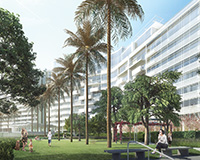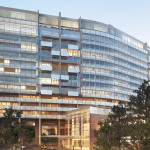When it comes to the original playground for the rich and famous, there really is only one postcode that cuts it. A stone’s throw west of Hollywood, it is a world where megastars, mega bucks and mega mansions prevail. A world where competitively-sized infinity pools rule and where there is no greater claim than having more bathrooms than bedrooms in your sprawling, gated pile.
All this is the ultimate sign that you haven’t just made it in the land of the free, you have made it in 90210. Welcome to Beverly Hills.
This neighbourhood in Los Angeles may be small compared to the vast metropolis in its entirety. But there is more wealth flying around this six-square-mile celebrity mecca than in pretty much any other zip code in the whole of the US. In fact, New York City is the only one that tops it.
While the rich might keep flocking here, the hillscape is shifting, and an area that has been known for those vast, stand-alone mansions for so many years could be on the brink of a condominium revolution. But will an apartment block really be enough to convince the next swathe of proverbial superstar movie producers and their ex-model wives to turn their backs on the traditional palatial pads?
That is the hope of Beijing-based Wanda Group. China’s largest commercial property developer is on track to deliver a rare type of residential product to this lucrative market with a “modern California”-style hotel-serviced condominium development: the aptly named One Beverly Hills.
And if that wasn’t bold enough, the site happens to be one of the most infamous real estate casualties of the global financial crisis, known to many by another name: 9900 Wilshire Boulevard.
The site has changed hands many times over the past 10 years. With each owner – including a high-profile failed development attempt by Christian Candy’s CPC Group in 2008 – came grand plans to redevelop this prime plot into aspirational luxury residences. How does Wanda plan to reverse the fortunes of this troubled piece of real estate and turn it into a roaring success?
And will the condos be A-list enough to live up to their prospective occupants’ expectations? Wanda certainly hopes so.
What megastars want?
Rohan a’Beckett, deputy general manager of the group’s investments and securities department, believes the development will satisfy demand from long-term local residents looking to downsize without compromising on location and luxury.
“They want to stay in Beverly Hills,” he says. “They want to stay close to their friends in what is an incredible place to live. This development is focused on providing a lifestyle, convenience, location and an amenity profile that can satisfy those empty-nesters with a luxury condo.”
Hana Cha, managing director of urban new development at Savills associate The Agency, adds: “This is the first ‘modern California’ condominium project in Beverly Hills, built to the exacting standards of [Pritzker Prize-winning architect] Richard Meier. You don’t have to drive 20 minutes up windy roads to get home and people appreciate that.
“People are also simplifying their lives. They are getting rid of stuff and collecting experiences and memories instead. You don’t need a big house for that.”
The back story
But before looking in more detail at what lies ahead, it is worth taking a step back into the scheme’s complex and – for some – costly past, to fully appreciate Wanda’s ambitious plans for the site.
And when it comes to back stories, this scheme has one worthy of a feature film. Stops, starts, successes, failures, ups, downs and a hell of a lot of money. The tale of 9900 Wilshire is nothing short of epic.
This is a scheme that should have piqued interest as soon as it came to market in 2003. Large parcels of land in prime city locations rarely come up for grabs and this eight-acre site was the biggest remaining development plot in Beverly Hills. Better still, it came with the 90210 zip code.
But when Beverly Hills-based real estate and development company New Pacific Realty bought the site for $33.5m (£25.3m) in 2004, it came with a tenant holding a long-term lease.
The Robinsons-May department store had occupied the site since 1952. According to Laurie Lustig-Bower, CBRE’s executive vice president of capital markets, who brokered the sale of 9900 Wilshire in 2007 when New Pacific decided to call it a day and again in 2014, there was no development potential.
“The site was encumbered with a long lease that I think might have been 20 years or more.” But, says Lustig-Bower, When Federated Department Stores bought the Robinsons-May company, it already owned a Bloomingdales around the corner and closed the store.” She adds: “The tenant was able to negotiate an exit from the lease and when that happened the land value changed overnight.”
That was in 2007. After the store was closed New Pacific Realty filed plans with the City of Beverly Hills for a 12-storey luxury residential-led project with 252 flats and 1,000 underground parking spaces. The project, dubbed 9900 Wilshire Boulevard, was designed by Richard Meier.
By April 2007, before the planning request had even been approved, New Pacific sold the development on for an eye-watering $500m – a 1,392% increase in value. Eyebrows were raised on both sides of the Atlantic.
The buyer was a joint venture between Christian Candy’s Guernsey-based CPC Group, Icelandic bank Kaupthing and London restaurateur Richard Caring – a consortium already working together on the three-acre former Middlesex Hospital site known as NoHo Square in London, which the trio bought for £175m in 2006.
The new jv completed the planning process on 9900 Wilshire in April 2008, despite local concerns that the project would bring more traffic to an already congested area. Approval was given for 235 condominiums, 4,200 sq ft of restaurants, 11,656 sq ft of shops, and a three-acre public garden. Meier’s design remained in play while Christian and his brother Nick’s firm Candy & Candy was named as development manager and interior designer on the project, which they estimated would cost $600m.
Approval was given for 235 condominiums, 4,200 sq ft of restaurants, 11,656 sq ft of shops, and a three-acre public garden. Meier’s design remained in play while Christian and his brother Nick’s firm Candy & Candy was named as development manager and interior designer on the project, which they estimated would cost $600m.
“The market hadn’t seen anything new, condominium-wise, built in a long time. CPC had the idea to do a super-prime luxury building,” says Lustig-Bower. “They looked at our inventory in the area and didn’t see much that could compete with a project like this.”
And then the global economy collapsed. Financial institutions across the world began toppling like dominoes in the autumn of 2008 and Kaupthing was among them. It failed on 9 October, the same day that the jv’s $356.5m loan on 9900 Wilshire matured.
The Candy brothers reportedly consulted two top City law firms before filing a termination notice with Kaupthing and announcing that CPC had seized control of both the Beverly Hills and London developments. But the Icelandic bank refuted the claim and struck back with a warning that it was a whisker away from calling in a £200m loan to the jv on Noho Square.
The threat of a long and bloody court battle was averted by the end of October when the two parties agreed to settle with a straight swap of equity in the two projects. Kaupthing surrendered its stake in 9900 Wilshire in exchange for CPC’s share of Noho Square (which eventually went on to become Exemplar and Aviva Investors’ Fitzroy Place). CPC, in turn, took ownership of 9900 Wilshire, with Caring staying on as a minority stakeholder.
But by February 2009, the US luxury residential market had crashed alongside the economy, making funding the build a tougher challenge and leading the Candys to consider turning part of the project into a premium hotel because, as Nick Candy said at the time: “I can’t get financing on 250 condominiums.”
Of course, there still remained the matter of the unpaid loan. In 2009, the Candys tried to renegotiate the terms with their main creditor, Banco Inbursa, the Mexican banking group owned by billionaire Carlos Slim, but the property fell into foreclosure and in March 2010 they were forced to hand over the keys to what would have been their first US development project.
The bank sold the site later that year for $148.3m to a consortium of Asian investors, Joint Treasure International, which intended to “pursue the development of luxury residences”.
The department store lay vacant for three years while Joint Treasure International waited for the market to mature, says Lustig-Bower,
“Joint Treasure held it for a while because it wanted to build and time the development with the market,” she says. “It wasn’t until 2014 that it had a change of business plan and decided to sell. The market had come back. It could make a good profit without needing to build and could still leave money on the table for the next buyer to be profitable.”
The store was finally demolished in 2014 and a month later it was sold to Dalian Wanda Group for $420m, with Thomas Yiu, a senior adviser at Joint Treasure, saying that the opportunity to sell the land was too attractive to pass up.
What next?
So what does the new owner have planned for this previously troubled site?
In short, Wanda hopes it will attract Beverly Hills locals looking to downsize from their mansions in the hills without giving up the luxury lifestyle. It is also targeting affluent international buyers from the likes of China, Hong Kong and Dubai looking for a slice of full-service urban living that they are familiar with.
The 193 homes will range from one-bedroom condos through to five- and six-bedroom penthouses (in the US you buy a condo and rent an apartment), each with its own direct elevator access, open plan living space and floor-to-ceiling windows. The residences will be serviced by the amenities of the hotel, which include rooftop restaurant, bar and pool, with views of Los Angeles Country Club.
The transaction was completed amid reports that the developer planned to plough $1.2bn into the build – double what the Candys estimated it would cost in 2008 – although the company today says the budget has yet to be finalised. The Richard Meier design for which CPC received planning permission remains largely unchanged.
“We haven’t finalised or set a construction budget yet, but essentially the project – the total square footage, the height, the massing and the building envelope – we are keeping entirely the same,” says a’Beckett. “Our proposal at the city right now is to remove 42 of the residential units and replace that area with a 134-room luxury boutique hotel.”
Wanda hopes that the planning application process will be complete by the end of the year. If approved there will be, in addition to the hotel and luxury flats, 1,140 parking spaces, almost four acres of gardens, two restaurants, a bar, and event space for up to 285 seated guests.
The hotel plan echoes the Candys’ 2008 bid to make the residential-led development a more attractive investment opportunity. But for Wanda it makes perfect sense. It is already the largest luxury hotel management company in China, where it owns 84 five-star and super five-star properties with a total of 26,073 bedrooms.
Chairman Wang Jianlin said in 2013 that the company can afford to spend $5bn on foreign assets, and the Beverly Hill scheme is one of six hotel-focused forays into the international scene.
But with hotels playing a pivotal part in Wanda’s international real estate growth, was it wise to buy the Beverly Hills site without a guarantee that planning for a hotel will be approved? a’Beckett is confident.
“The condos are approved so that project would still go forward,” he says.
“But hotels are incredibly rich contributors to a US city’s revenue sources because they provide Transient Occupancy Tax. By introducing just 134 hotel rooms, the city on an annual basis would earn an extra $6m.”
The financial argument for the city to grant planning permission for the hotel is certainly strong. And the commitment to completing this development either way must be reassuring for avid observers of the 9900 story.
So while the ultimate outcome of this tale of triumph over adversity remains to be seen, a fresh new name and a confident new owner could be just what is needed to see the saga of 9900 Wilshire Boulevard finally fade to black.
• To send feedback, email janie.stamford@estatesgazette.com or tweet @JanieStamford or @estatesgazette
















